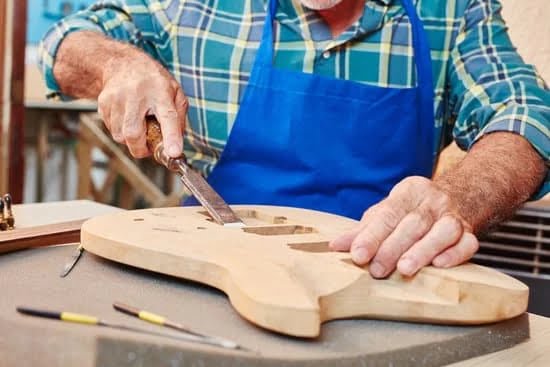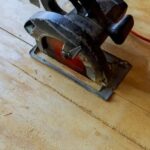Paint drips on woodwork can be a frustrating and unsightly problem. Whether you are a seasoned DIY enthusiast or a homeowner looking to give your space a fresh new look, knowing how to remove paint drips from woodwork is essential. These small imperfections can have a significant impact on the overall appearance of your wood surfaces if left unaddressed.
Furthermore, if not removed promptly, paint drips can lead to long-term damage and even compromise the integrity of your woodwork. In this article, we will discuss various techniques and methods to help you effectively remove paint drips from your woodwork and restore it to its pristine condition.
When it comes to maintaining clean woodwork, removing paint drips is crucial. Paint drips can significantly compromise the overall aesthetic value of your wooden surfaces. They can create unsightly blemishes and distract from the natural beauty of the wood grain. Whether you have painted trim, baseboards, or furniture pieces, ensuring that they are free from paint drips will make all the difference in achieving a polished and professional finish.
Beyond their visual impact, unaddressed paint drips can also cause long-term damage to your woodwork. As the paint dries and hardens, it becomes difficult to remove without potentially causing further harm to the surface beneath it. Additionally, as time goes on, these dried paint drips can accumulate dirt and grime, making removal even more challenging.
In addition to discussing various techniques for removing paint drips from woodwork, this article will address preventive measures you can take during future painting projects to minimize or avoid painters drop cloth these issues altogether.
By being proactive in protecting your wood surfaces during painting projects and learning effective removal techniques for any accidental messes that may occur along the way, you will be able to achieve cleaner results and preserve the pristine condition of your woodwork for years to come.
Understanding the Types of Paint Drips on Woodwork
Paint drips on woodwork can be a common occurrence during painting projects, and it’s important to understand the different types of paint drips that can occur. By gaining this understanding, you can effectively choose the right techniques and materials to remove them without causing any damage to the woodwork.
Differentiating Between Water-Based and Oil-Based Paint Drips
One of the first steps in removing paint drips from woodwork is identifying whether the paint is water-based or oil-based. Water-based paints are more commonly used due to their quick drying time and easy cleanup with water. On the other hand, oil-based paints take longer to dry but provide a more durable finish. It’s important to note that different removal techniques and solvents may be required for each type of paint.
Characteristics and Challenges of Each Type of Paint Drip
Water-based paint drips tend to be easier to remove because they can often be softened with water or a mild detergent solution before being easily scraped off. However, if the paint has dried completely, sanding may be necessary for effective removal.
Oil-based paint drips, on the other hand, require more effort and specialized solvents for removal as they aren’t soluble in water. The challenge lies in finding solvents that effectively dissolve these paint drips without damaging the woodwork.
Understanding these differences between water-based and oil-based paints will help you determine the best approach to effectively remove paint drips from your woodwork while protecting its integrity. With this knowledge in hand, you’ll be better equipped to gather the necessary tools and materials for successful paint drip removal.
Gathering the Necessary Tools and Materials
When it comes to removing paint drips from woodwork, having the right tools and materials on hand is crucial for a successful and efficient process. Before you begin tackling those unsightly drips, make sure you have everything you need to get the job done effectively.
List of Tools
To start, gather the following tools:
- Putty knife or scraper: A putty knife with a flat, flexible blade is essential for scraping off dried paint drips. Opt for one with a comfortable grip to avoid hand fatigue during the process.
- Sandpaper: Depending on the severity of the paint drip, you may need sandpaper to smooth out any rough areas after scraping off the paint. Choose finer grit sandpaper for minor imperfections and coarser grits for more stubborn drips.
- Microfiber cloth or sponge: It’s important to have a clean and absorbent cloth or sponge nearby to wipe away any dust or residue left behind after removing the paint drip.
- Safety goggles and gloves: Protect your eyes with goggles and your hands with sturdy gloves while working with solvents or chemicals.
Chemical Solvents or Natural Alternatives
Depending on the type of paint that caused the drips, there are different approaches you can take when it comes to choosing chemical solvents or natural alternatives.
For water-based paint drips:
- Rubbing alcohol: Soaking a cloth or sponge in rubbing alcohol can help soften and dissolve water-based paint drips.
- Dish soap and warm water: Mixing some dish soap with warm water creates a mild cleaning solution that can effectively remove fresh water-based paint drips.
- Commercial cleaning products: There are also various commercial cleaning products available specifically formulated for removing dried water-based paint from surfaces.
For oil-based paint drips:
- Mineral spirits: Using mineral spirits can help break down hardened oil-based paint drips without damaging the woodwork.
- Acetone: While acetone should be used with caution due to its strong chemicals, it can effectively remove stubborn oil-based paint drips.
- Natural alternatives: If you prefer to use natural alternatives, citrus-based solvents or vinegar mixed with warm water can be effective in breaking down oil-based paint drips.
Having a well-stocked toolbox and choosing the appropriate solvents or natural alternatives will ensure that you have everything you need to successfully remove paint drips from your woodwork. Remember to always follow safety guidelines and use these tools and materials responsibly.
Preparing the Woodwork Before Removal
Before diving into the process of removing paint drips from woodwork, it’s important to take a few necessary steps in preparing the woodwork. By properly preparing the woodwork, you can ensure a safe and effective paint drip removal process while minimizing potential damage to the surface. Here are some essential tips for preparing the woodwork before removing paint drips:
Ensure Proper Ventilation
Before starting any paint drip removal process, make sure the area is well-ventilated. Open windows and doors to allow for proper air circulation and reduce exposure to fumes from chemicals or solvents that may be used.
Protect Surrounding Surfaces
It’s crucial to protect any surrounding surfaces, such as walls or flooring, from accidental damage during the paint drip removal process. Use drop cloths or plastic sheets to cover nearby areas and prevent any splatters or spills from causing additional mess or staining.
Put on Protective Gear
When working with chemicals, solvents, or heat sources, it’s important to prioritize safety by wearing protective gear. Put on gloves, safety goggles, and a mask to protect your skin, eyes, and respiratory system from any potential harm.
Clean the Surface
Before attempting to remove paint drips, clean the surface of the woodwork thoroughly using a mild detergent diluted in warm water. This will help remove any dirt, grime, or oils that could interfere with effective paint drip removal.
Tape Off Adjacent Areas
If there are specific areas on the woodwork that you want to avoid getting any chemicals or solvents on during the removal process (such as decorative details), use painter’s tape to create a barrier around those areas.
By following these preparation tips, you can ensure a smooth and successful paint drip removal process while protecting the woodwork from any potential damage. It’s essential to prioritize safety, cleanliness, and careful attention to detail during this stage to achieve the best possible results.
Techniques for Removing Water-Based Paint Drips
Water-based paint drips can be easier to remove compared to oil-based paint drips, but it still requires the right techniques and tools. Here are some step-by-step instructions on how to effectively remove water-based paint drips from woodwork:
- Scrape off the Excess Paint: Start by gently scraping off any excess paint drips from the woodwork using a plastic scraper or putty knife. Be careful not to scratch the surface of the wood while doing this.
- Sand the Area: After removing the excess paint, use fine-grit sandpaper to sand down the remaining paint drip. Sand in a circular motion until the paint drip is smooth and level with the rest of the wood surface.
- Use Warm, Soapy Water: For small and light water-based paint drips, you can try using warm, soapy water to remove them. Dip a cloth or sponge into the soapy water and gently scrub at the paint drip until it comes off.
- Specialized Paint Removers: If warm, soapy water doesn’t work or for stubborn paint drips, you may need to use a specialized paint remover designed for water-based paints. Follow the manufacturer’s instructions when using these products and make sure to wear protective gloves.
- Solvents: If all else fails, you can try using solvents like rubbing alcohol or mineral spirits as a last resort. Apply a small amount of solvent onto a clean cloth and carefully dab at the paint drip until it dissolves.
Remember to always test any cleaning method or product on a small, inconspicuous area of the woodwork before applying it to larger areas. This will help ensure that there are no adverse effects on your woodwork.
By following these techniques, you can successfully remove water-based paint drips from your woodwork without causing any damage or leaving behind unsightly marks.
Techniques for Removing Oil-Based Paint Drips
Oil-based paint drips can present a unique challenge when it comes to removal from woodwork. These types of paint drips are known for their durability and resistance, making them harder to remove compared to water-based paint drips. However, with the right techniques and precautions, you can effectively eliminate oil-based paint drips without causing damage to the woodwork.
Before diving into the various techniques, it’s crucial to take appropriate precautions to avoid any unintended consequences or harm. Start by protecting yourself with safety goggles, gloves, and a respirator mask if working indoors. Adequate ventilation is also essential when using solvents or other chemicals.
One technique for removing oil-based paint drips is using heat. This method involves using a heat gun or hair dryer to warm up the paint drip until it softens and becomes pliable. Once softened, gently scrape off the loosened paint with a putty knife or scraper. It’s important to be cautious not to apply too much heat or hold the heat source too close to avoid scorching or damaging the wood.
Another technique is using solvents specifically designed for oil-based paints. Start by testing a small inconspicuous area of the affected woodwork with the solvent to ensure that it does not cause discoloration or damage. Apply the solvent onto a clean cloth and rub it onto the paint drip in a circular motion. Allow the solvent some time to penetrate and dissolve the paint before gently wiping away with a clean cloth.
In some cases, scraping may be necessary for stubborn oil-based paint drips. Use a plastic scraper rather than a metal one to prevent scratching the surface of the woodwork. Be gentle but firm while scraping and work in smooth motions following the direction of the grain.
| Technique | Description |
|---|---|
| Heat Method | Use a heat gun or hair dryer to warm and soften the paint drip before gently scraping it off with a putty knife or scraper. |
| Solvent Method | Apply a solvent specifically designed for oil-based paints onto a clean cloth and rub it onto the paint drip. Allow the solvent to penetrate, then wipe away with a clean cloth. |
| Scraping Method | Use a plastic scraper to gently but firmly scrape off stubborn oil-based paint drips in smooth motions following the direction of the wood grain. |
Addressing Deeply Embedded Paint Stains on Woodwork
When paint drips on woodwork are not promptly addressed, they can become deeply embedded stains that are more challenging to remove. These stubborn stains can detract from the overall appearance of the wood and require additional techniques to effectively eliminate them. In this section, we will explore some methods for addressing deeply embedded paint stains on woodwork.
One method for tackling tough paint stains is using a heat gun. This tool emits hot air that softens the paint, making it easier to scrape off. However, it is crucial to exercise caution when using a heat gun as excessive heat can scorch and damage the wood. It is recommended to start with low heat settings and keep the heat gun moving at all times to minimize the risk of overheating.
Another option for removing deeply embedded paint stains is through the use of chemical paint strippers. These products contain powerful solvents that dissolve multiple layers of paint, including stubborn stains. Before applying a chemical stripper, it’s essential to follow safety precautions such as working in a well-ventilated area and wearing protective gloves and eyewear.
| Method | Description | Tips |
|---|---|---|
| Heat Gun | Emits hot air to soften the paint for scraping. | – Start with low heat settings\n – Keep the heat gun moving to avoid scorching\n – Use in a well-ventilated area\n – Wear protective gloves and eyewear |
| Chemical Paint Strippers | Solvents that dissolve multiple layers of paint. | – Work in a well-ventilated area\n – Wear protective gloves and eyewear\n – Follow manufacturer’s instructions carefully |
It is important to note that both the heat gun and chemical paint strippers should be used with caution as they can pose risks if mishandled or applied improperly. Always follow the manufacturer’s instructions and consider consulting a professional if you are unsure about using these techniques.
By addressing deeply embedded paint stains on woodwork, you can restore the beauty of your wooden surfaces and achieve a pristine appearance. However, it is crucial to approach these advanced techniques with care and prioritize safety to avoid causing further damage to the wood or compromising your own well-being.
Restoring and Refinishing Woodwork After Paint Drip Removal
Once you have successfully removed the paint drips from your woodwork, it is important to restore and refinish the surface to ensure a seamless and polished appearance. This section will provide guidance on evaluating the damage, determining the need for refinishing, and offer tips and techniques for achieving a professional finish that matches existing finishes.
Before starting the restoration process, carefully evaluate the condition of the woodwork. Look for any scratches, gouges, or discoloration that may have occurred during the paint drip removal. If there are only minor imperfections, you may be able to skip refinishing and proceed with touch-ups.
If refinishing is necessary, start by sanding the affected area using fine-grit sandpaper. This will help smooth out any rough spots and prepare the surface for finishing. Make sure to sand in the direction of the wood grain to avoid creating visible scratches.
After sanding, thoroughly clean off any dust or debris from the surface. You can use a tack cloth or a damp cloth followed by a dry cloth to achieve a clean surface free of residue.
Next, choose an appropriate finish that matches the existing finish on your woodwork. This may involve selecting a clear coat varnish or stain that closely resembles the original color and sheen. Test the chosen finish on a small inconspicuous area before applying it to the entire piece to ensure it blends seamlessly.
Apply thin coats of finish using a brush or lint-free cloth, following the manufacturer’s instructions for drying time between coats. Make sure to apply even strokes in one direction to avoid streaks or bubbles in the finish.
Allow sufficient drying time for each coat before lightly sanding with fine-grit sandpaper between coats if necessary. This will help achieve a smoother finish.
Finally, once all coats of finish have been applied and dried completely, inspect your restored woodwork for any touch-ups or areas that may require additional attention. Make any necessary adjustments to achieve a pristine and uniform appearance.
Restoring and refinishing woodwork after paint drip removal can be a rewarding process that not only restores the natural beauty of the wood but also adds longevity to its lifespan. With careful evaluation, appropriate finishing techniques, and attention to detail, you can achieve a professional finish that seamlessly matches existing finishes and enhances the overall aesthetic value of your woodwork.
Preventive Measures to Avoid Future Paint Drips
Once you have successfully removed paint drips from your woodwork, it is important to take preventive measures to avoid future occurrences. By implementing these strategies, you can ensure that your woodwork remains pristine and free from unsightly paint drips during future painting projects.
One of the most effective ways to prevent paint drips is by using proper painting techniques and tools. Start by using high-quality brushes or rollers that are designed for the type of paint you are using. Cheap brushes or rollers may shed bristles or fibers, causing paint drips. Additionally, make sure to load the brush or roller with the right amount of paint – too much paint on the tool can lead to drips and streaks.
Preparing the surface properly before painting can also help prevent paint drips. Remove any loose or flaky paint, sand rough spots, and clean the surface thoroughly. This will create a smooth and even base for your new coat of paint, reducing the likelihood of drips.
Protecting surrounding surfaces is another critical step in preventing paint drips. Cover floors, furniture, and other nearby objects with drop cloths or plastic sheets to catch any potential spills or splatters. Use painter’s tape to mask off areas where you don’t want paint, such as trim or windowsills.
Finally, maintain steady and consistent brush strokes while painting. Avoid overloading the brush with too much paint at once, as this can cause excess dripping. Take your time and be mindful of removing any excess paint on the brush before applying it to the woodwork.
By following these preventive measures, you can minimize the chances of encountering troublesome paint drips on your woodwork during future painting projects. Taking extra care during preparation and execution will result in a cleaner finish that allows your woodwork to shine without any unsightly blemishes.
Conclusion
In conclusion, by following the paint drip removal techniques outlined in this article, you can achieve pristine woodwork and preserve its aesthetic value. The importance of maintaining clean woodwork cannot be overstated, as paint drips can significantly impact the overall appearance of your wood surfaces. Not only do they create an unsightly blemish, but if left unattended, they can also cause potential damage to the woodwork.
Throughout this blog post, we have discussed various methods for removing different types of paint drips, including water-based and oil-based paints. We have provided step-by-step instructions and recommended tools and materials to help you effectively remove these paint drips from your wood surfaces. In addition, we have explored advanced techniques for addressing deeply embedded paint stains and shared tips for restoring and refinishing your woodwork.
However, prevention is always better than cure. To avoid future paint drips on your woodwork, it is important to take preventive measures during any painting project. By following proactive strategies such as protecting the surfaces surrounding the woodwork and minimizing paint drips during application, you can greatly reduce the likelihood of encountering these issues in the first place.
Frequently Asked Questions
How do you remove dried paint drips from trim?
To remove dried paint drips from trim, you can start by using a scraper or putty knife to gently scrape off as much of the dried paint as possible. Be careful not to damage the trim in the process. If there are any remaining paint spots, you can try using a mild solvent such as rubbing alcohol or mineral spirits on a clean cloth, and gently rub the affected area until the paint starts to dissolve.
You may need to repeat this process several times until all the dried paint is removed. Afterward, be sure to clean the trim with soap and water to remove any residue left behind by the solvent.
How do you fix paint drips on wood trim?
Fixing paint drips on wood trim requires some careful attention and patience. First, use a putty knife or scraper to carefully scrape off any excess paint that has formed drips or runs on the surface of the trim. Sanding can also help in smoothing out these drips; use fine-grit sandpaper and gently sand in the direction of the wood grain until the surface is even with the rest of the trim.
Afterward, wipe away any dust or debris before applying touch-up paint using a small brush. Take care to blend in the touch-up paint with the surrounding area by feathering outwards from where you applied it. Allow it to dry completely before assessing if another layer is needed.
How do you get old dried paint off of wood trim?
Removing old dried paint from wood trim requires a bit more effort and caution to avoid damaging the underlying wood surface. Start by softening up the old dried paint by applying heat with a heat gun or hairdryer on medium heat setting; hold it about 6-8 inches away from the painted area and move it slowly back and forth until you see some bubbling or loosening of the old paint layers. Once softened, use a plastic scraper or putty knife to carefully scrape off as much of the old paint as possible without scratching or gouging into the wood trim. If necessary, you can further soften stubborn paint spots using a mild solvent like mineral spirits or rubbing alcohol applied with a clean cloth.
Gently rub in small circular motions until the paint starts to dissolve, then wipe away the dissolved paint with a clean cloth. Be sure to work in well-ventilated areas and use appropriate safety precautions when working with solvents. Remember, this process may require multiple rounds of scraping and cleaning until all the old dried paint is completely removed.

Hi everyone! I’m a woodworker and blogger, and this is my woodworking blog. In my blog, I share tips and tricks for woodworkers of all skill levels, as well as project ideas that you can try yourself.





